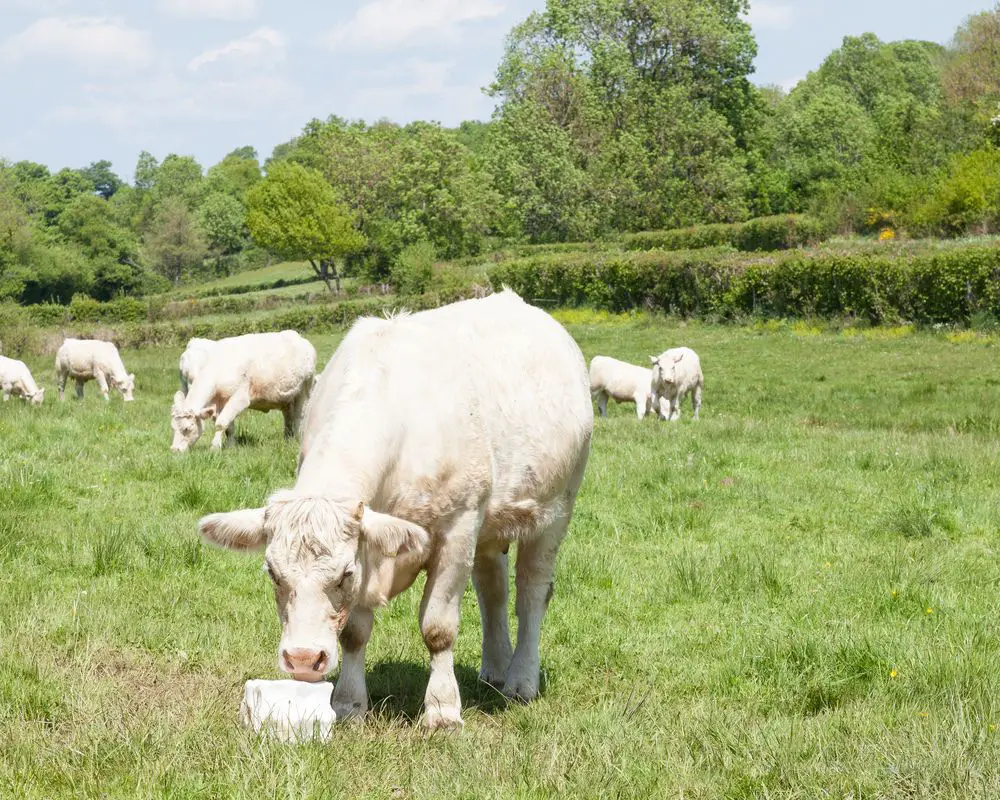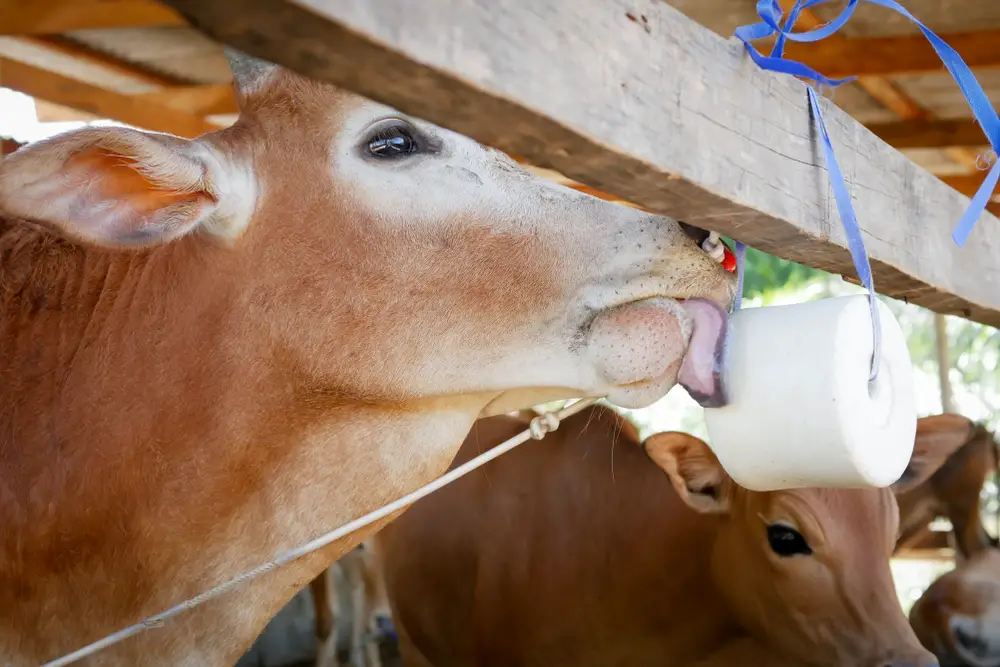Cows lick salt daily because the calcium helps their bone health, weight gain and muscles, while the sodium helps in producing milk. It also helps maintain their immune system and restore salt lost by sweating and discarding waste material. Cows require around 0.005 to 0.01% of its body weight in salt every single day.
Salt is a vital element for a cow’s survival, otherwise, they can get seriously ill or die. While knowing that cattle require salt is the easiest part, it’s not always easy for farmers to tell when their cattle need salt and how much of it they require.
Table of Contents
Why Do Cows Lick Salt?
As a crucial requirement in the body, cows must lick salt because:
- The calcium in salt helps maintain strong bones, muscles, and a healthy nervous system
- Sodium is essential in the creation of milk
- Salt helps with weight gain, a crucial aspect for cattle raised as beef
- Salt is necessary for proper blood clotting
- Salt helps maintain regular heartbeats
- The chloride in salt helps with digestion and balancing the levels of acids in the cow’s body
- Salt helps with water regulation. When cows eat salt, they must drink water to avoid salt toxicity.
- Salt is essential for fluid balancing in the body to ensure vital organs like the kidneys, heart, and liver function properly.
- Sodium helps with the absorption of calcium.
- Salt has essential minerals required to support a cow’s immune system
- Salt intake restores the salt lost through saliva, feces, sweating, and urination.
- Salt helps counter high levels of potassium in the body, which can be detrimental.
- Salt helps with muscle movement.
Cows must lick enough salt because their bodies can’t store it, making repeated intake necessary to restore the lost amounts.
The salt taken by cows helps them perform basic metabolism and primary body functions, without which their survival is threatened.
Salt is the common name for sodium chloride, and besides sodium and chloride, it also has trace minerals like calcium, selenium, magnesium, and phosphorus. If these are in low quantities in the salt available, salt supplements are necessary to ensure cattle get all the minerals essential for survival.
How Much Salt Do Cows Require?
A cow requires about 0.005 to 0.01% of its body weight in salt daily.
The recommended daily salt intake is generally 0.01% of a cow’s body weight.
The amount of salt a cow takes daily depends on various factors, such as size, age, crucial developmental stages, purpose, and activity.
For example, dry cows should consume salt amounting to about 0.08% of their daily dry matter intake, while lactating cows should consume as much as 0.1% of their daily dry matter intake.
Dairy cows require more salt than beef cattle to keep up with milk production. Pregnant and in-lactation cows need more salt because, during these times, their bodies use a lot of calcium for fetal development and milk production.

When you calculate the daily salt intake as a percentage (0.005-0.01%) of a cow’s body weight, a 1,400-pound animal will consume between 31.75 grams (0.07 pounds) and 63.5 grams (0.14 pounds) daily. This amount may differ based on the factors mentioned above.
Other aspects that determine how much salt a cow requires daily include changes in feed combinations, quality of grass, and quality of forage.
For example, cows feeding on younger grass require more because it contains lower levels of salt and trace minerals. Cows feeding on a lot of forage require more salt and supplemental minerals.
The location where you raise your cows can also affect the type and how much salt you must provide to your cows, owing to mineral imbalances across different regions.
For instance, Western Canada soils have iodine, zinc, selenium, manganese, cobalt, and copper deficiencies. In the United States, iodine and iron deficiencies are prevalent in cattle raised in the Midwest, Northeast, Great Lakes, and the Rocky Mountains.
Problems From A Lack of Salt
Salt deficiencies in cows can cause health problems and conditions such as:
- Milk fever
- Weight loss
- Poor weight gain
- Failure to come into heat
- Pica (cows start eating odd things like rags and carcasses of other animals in search of salt—these items can be detrimental because they are unnatural food for cows).
- Rickets
- White muscle disease
- Tetany
- Downer cow syndrome (which may also be caused by other conditions, some of which are caused by salt deprivation).
- A noticeable decline in milk yield
- Death from extreme cases of heat stress
How Often Do Cows Require Salt?
Cows require salt all the time, meaning you must provide free-choice salt alongside fresh free-choice water to prevent incidences of salt poisoning, though rare.
How To Provide Salt To Your Cows
You have two main options for providing pure salt and salt supplements to your cows. You can provide loose salt, which is better because salt-deprived cows can consume more in a short time. Loose salt is also better when the temperatures are extremely low for cows to lick salt blocks.
Talking of salt blocks, cows can lick blocks of salt in warmer months in summer, fall, and spring because the blocks will be warm enough for the rough tongue. However, they aren’t ideal when cows have severe salt deficiencies since they provide fewer amounts of salt per licking.

The mineral deficiencies in your soil should inform the type of salt lick you offer your cow because these will reflect in your cows when they take feeds deficient in those minerals.
You can choose from red, yellow, brown, black, white, or blue salt licks based on the following aspects:
- White salt blocks as a source of salt only (sodium chloride)
- Red salt licks to provide normal salt, iron, and iodine
- Black salt blocks to provide molybdenum, iron, copper, iodine, zinc, selenium, and manganese to cattle with selenium deficiency. Avoid giving cows excess selenium as it can cause lameness, death, and white muscle disease.
- Blue salt blocks to provide iodine and cobalt.
- Brown salt blocks to provide zinc, copper, selenium, cobalt, molybdenum, iron, manganese, iodine, and copper. Some may have magnesium and potassium.
- Rock salt (the unrefined form of sodium chloride) is also used as a natural salt lick. Himalayan salt licks are a good example of rock salt, with most sources selling refined forms.
The temptation to feed table salt to cows is common among farmers. However, cows shouldn’t eat food salt because it has finer grains that the rough tongue won’t sense easily, making it difficult for cows to know when they have had enough.
You should provide mineral salts to cows near a fresh water supply point. While cows rarely eat excess salt, cases of salt toxicity are common if they have been denied salt for a long time and overeat when they finally get it.
Salt licks are usually hung from a height to keep them away from dirt, but the cows must be able to reach the block of salt without straining.
It’s best to provide loose salt in a small feeding container. Sometimes, cows will refuse to eat salt on its own. If this happens, you can mix textured grains or dried molasses with coarse salt, but you should know the exact ratio of salt to feed to use.
